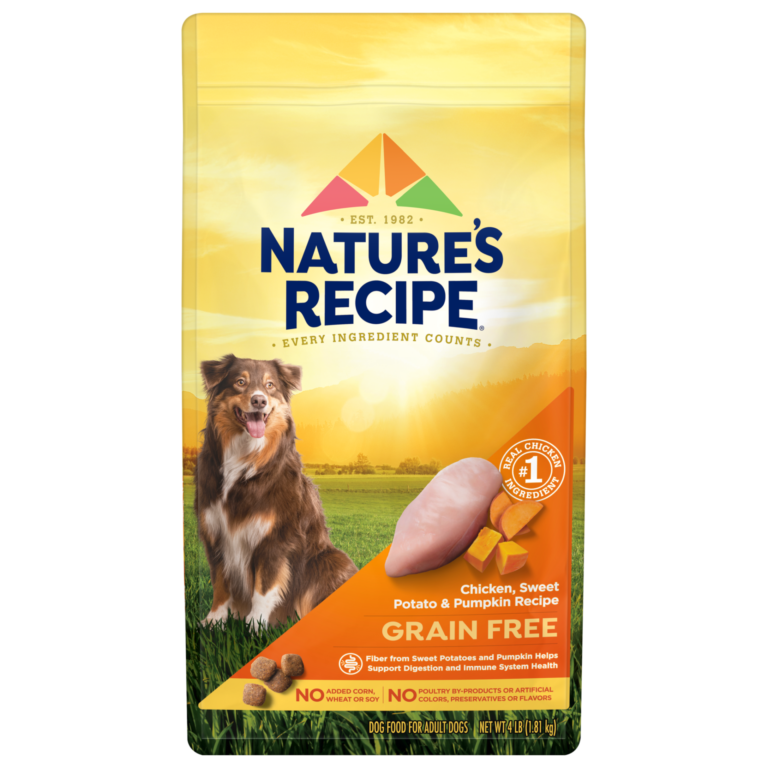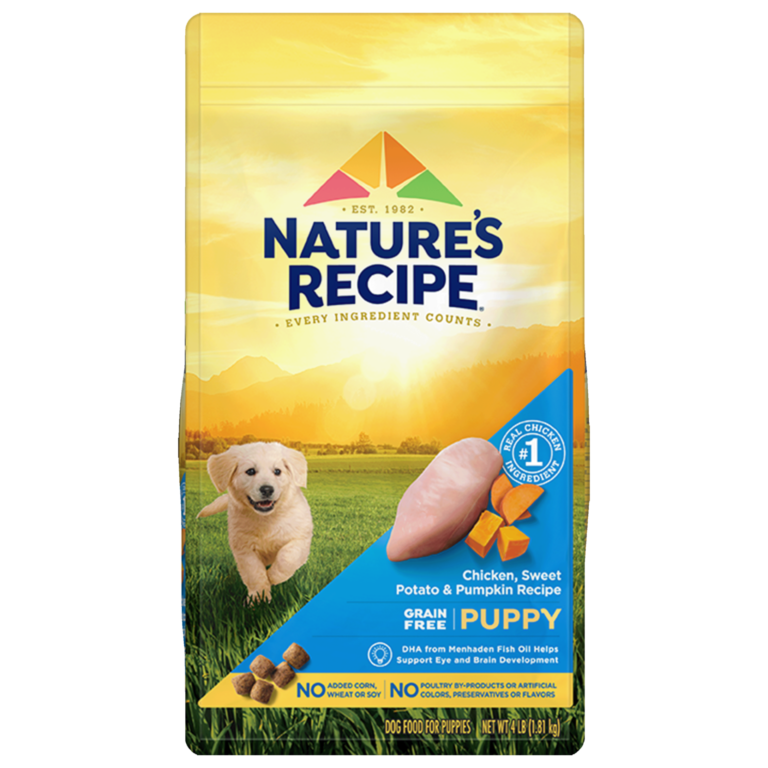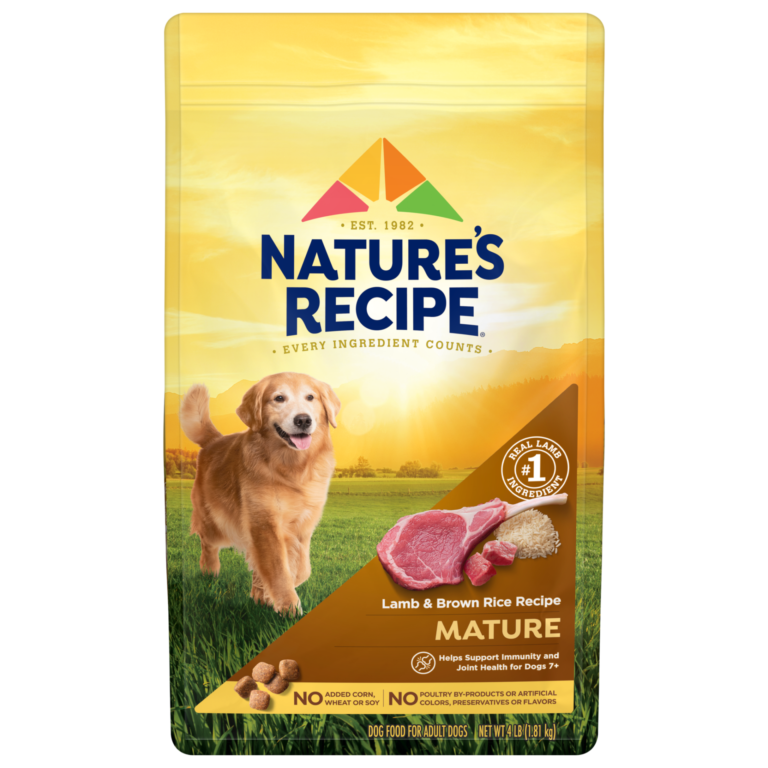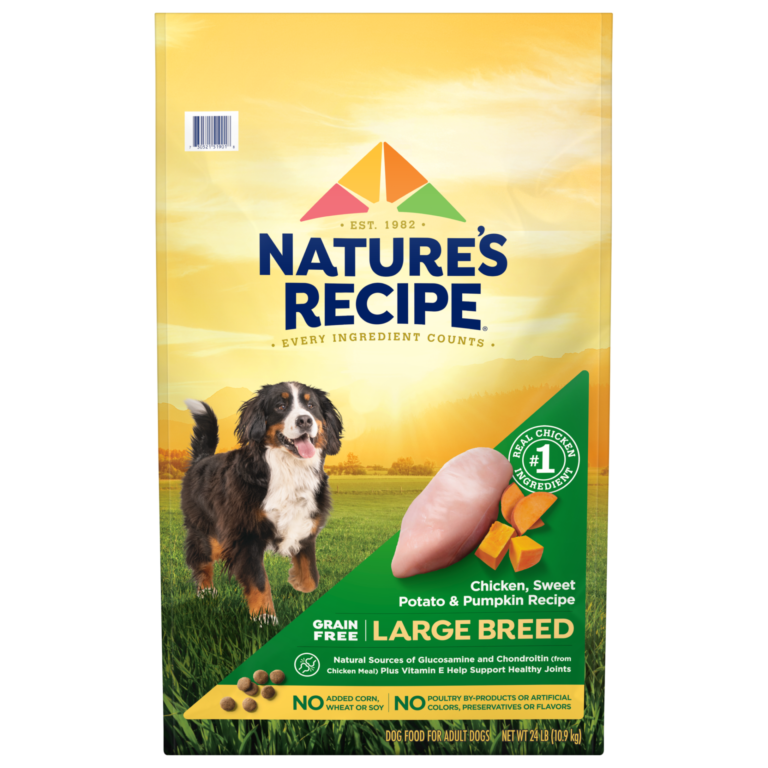Nature’s Recipe has positioned itself as an affordable natural dog food option in a crowded marketplace. Founded in 1981.
Their selling proposition centers around no artificial colors or flavors, no corn or wheat fillers, and real meat as the first ingredient in most formulas. The brand emphasizes its “purposeful recipes” designed to meet specific needs—from large breed formulas to small breed kibble, grain-free options for sensitive dogs, and life stage-specific recipes for puppies and seniors.
Let’s examine several of their popular formulas to see where Nature’s Recipe succeeds and where it falls short of optimal canine nutrition.
- Taurine is included due to its known role in supporting cardiac function, especially in diets low in animal protein.
- Probiotics
- Appropriate Calcium/Phosphorus ratios
- Good calcium/phosphorus ratios
- No Artificial Ingredients or Common Allergens
- Above AAFCO minimum
- Reasonable Price Point
- Decent Palatability : Consumer reviews consistently mention that dogs find the food appetizing
- Plant-Based Proteins: Estimated 40-60% of protein content may come from plant-based sources in some formulas.
- Moderate to High carbohydrate content: many formulas contain 38-42% carbohydrates
- Moderate to low protein levels : active dogs especially need higher protein levels
- Concerning Omega-6 to Omega-3 Ratios : most formulas have omega ratios between 8:1 and 12:1.
NATURE’S RECIPE Dry Food Review Ratings
We will provide a detailed analysis of one recipe, followed by quick reviews of a few other recipes from the brand.
NATURE’S RECIPE Grain Free Chicken, Sweet Potato & Pumpkin Recipe Dry Dog Food


46/100
Ingredients
| Criteria | Evaluation | Comments |
|---|---|---|
| Carbohydrate Levels | 🔴 High (39%) | Much too high for an obligate carnivore. Sweet potatoes may have a lower glycemic index than grains, but 39% carbs is still excessive for a dog’s optimal health. |
| Protein Levels | 🟠 Average (25%) | At 25%, the protein content falls in the “low” category but does meet AAFCO minimum standards (18% for adult maintenance). Still, dogs, especially active ones, would benefit from at least 30% protein for optimal muscle maintenance. |
| Protein-to-Calorie Ratio | 🟠 Average (72) | The protein-calorie ratio of 72 falls within the “average” range, this isn’t impressive for a product marketing itself as premium. Suggests too many calories from carbs rather than protein. |
| Protein-to-Phosphorus Ratio | 🟠 Average (31) | With a protein-to-phosphorus ratio of 31, this food is just barely in the “average” category. Higher would be better for long-term kidney health, especially for aging dogs. |
| Protein-to-Ash Ratio | ❓ Non-specified | Ash content isn’t specified, making it impossible to calculate this important ratio. This lack of transparency is concerning. |
| Fat Levels | 🟢 Excellent (12%) | At 12%, the fat content is in the ideal range and exceeds the AAFCO minimum (5% for adult maintenance). |
| Ash Content | ❓ Non-specified | No ash content is provided, which raises questions about mineral load and overall transparency. |
| Fiber Levels | 🟢 Good (4.5%) | The fiber content of 4.5% is within the ideal range, supporting digestive health without being excessive. |
| Moisture Levels | 🟢🟢 Excellent (10%) | At 10%, the moisture content hits the sweet spot for kibble, helping with palatability while maintaining shelf stability. |
| Calcium Levels | 🟢 Good (1%) | Calcium levels are in the ideal range at 1%, supporting bone health without risking excess mineral loads. Meets AAFCO minimum (0.5% for adult maintenance). |
| Phosphorus Levels | 🟢 Excellent (0.8%) | Phosphorus levels are appropriately below 1%, which is excellent for long-term kidney health. Meets AAFCO minimum (0.4% for adult maintenance). |
| Glycemic Index of Ingredients | 🟢 Excellent | No high-glycemic ingredients in the top positions is a positive, but still too many total carbs overall. |
| Animal vs. Plant-Based Protein Ratio | 🔴 Insufficient (40-60%) | Only 40-60% of the protein comes from animal sources. This is inadequate for dogs that thrive on animal proteins with complete amino acid profiles. Plant proteins are nutritionally inferior for canines. |
| Quality of Animal Protein Sources | 🟢 Good | Fresh chicken plus chicken meal provides good quality protein, but the total animal protein percentage remains too low overall. |
| Type of Preservatives Used | 🟢 Good | Uses natural preservatives like mixed tocopherols, citric acid, and rosemary extract instead of artificial preservatives. |
| Manufacturing Location Transparency | ❓ Non-specified | Manufacturing location is not clearly indicated, which raises questions about quality control and safety standards. |
| Cooking or Processing Method | ❓ Non-specified | No information provided about the cooking process, which impacts nutrient preservation and digestibility. |
| Quality and Source of Fats | 🟢 Good | Named sources of fats (chicken fat preserved with mixed tocopherols) provides transparency about fat quality. |
| Calcium-to-Phosphorus Ratio | 🟢 Good (1.25:1) | The Ca ratio of 1.25:1 falls within the optimal range for proper mineral balance and bone health. |
| Omega-6 to Omega-3 Ratio | 🔴 Very Unbalanced (12:1) | At 12:1, this ratio is dramatically too high. The ideal is under 5:1 to prevent chronic inflammation. This formula likely relies too heavily on omega-6 rich ingredients. |
| Contains Corn, Gluten, Wheat, Soy | 🟢 Good | No corn, wheat, gluten, or soy, which are common allergens and often used as cheap fillers. |
| Added Taurine | 🟢 Excellent | Contains added taurine, which is crucial for grain-free formulas to support heart health and prevent DCM. |
| Human-Grade Ingredients | 🔴 No | No indication that ingredients are human-grade, suggesting standard pet food quality. |
| GMO Status | 🔴 Concerning | No verification of non-GMO status, which is concerning given the presence of ingredients like canola meal that are commonly GMO. |
| Formula Testing | 🔴 No | No published feeding trials or scientific studies are available for this specific formula. The product appears to be formulated to meet AAFCO nutrient profiles rather than being subjected to feeding trials. |
Nature’s Recipe Grain Free Puppy Chicken, Sweet Potato & Pumpkin Recipe Dry Dog Food (Puppy)


47/100
A puppy formula that doesn’t quite deliver on what we would expect.
👉 Nutritional composition: 24% protein, 14% fat, 38% carbohydrates, 4% fiber, and 10% moisture. The protein-calorie ratio is 69 g/Mcal, which is acceptable for a puppy but not outstanding.
Yes, it contains chicken as the first ingredient, which seems positive. But be careful—we’re talking about fresh chicken that contains about 70% water. After dehydration during cooking, this “star” chicken will rank much lower on the list. Thankfully, there’s chicken meal as the second ingredient to ensure a minimum of animal protein.
Animal proteins represent between 40-60% of total proteins. Frankly, for a kibble intended for growing puppies, you’d expect a minimum of 70%. Puppies need high-quality proteins, not a mix of lower biological value plant proteins from canola, peas, and chickpeas.
Regarding carbohydrates, 38% remains high, even if sweet potatoes have a better glycemic index than traditional grains. The calcium content (1.2%) and phosphorus (1%) give a Ca ratio of 1.2, acceptable for a puppy but nothing more.
The added taurine is a positive point. However, the omega-6/omega-3 ratio of 10:1 is far too high—ideally, we aim for a maximum ratio of 5:1 to limit inflammation.
The most problematic aspect remains the carbohydrate quantity. A growing puppy needs quality proteins and fats, not a massive carbohydrate intake that will simply provide inexpensive energy.
This kibble might be suitable for medium-breed puppies with moderate growth, but certainly not for small, large or giant breeds where protein quality and nutritional density are crucial. For these dogs, look for formulas with a minimum of 28-30% predominantly animal proteins.
Fat content: 🟢 16%
Ash content: Unknown
Fiber content: 🟢 4.0%
Moisture content: 🟢 10%
Calcium content: 🟢 1.2%
Phosphorus content: 🟢 1.0%
Metabolizable energy: 362 kcal/cup
Omega-3 content: 0.25%
Omega-6 content: 2.2%
Carbohydrate content: 🟠 33%
Protein-to-calorie ratio: 75 g/Mcal
Calcium-to-phosphorus ratio: 🟢 1.2
Animal protein content: 🔴 40-60%
High-glycemic ingredients: 🟢 Low (sweet potatoes, pumpkin)
Corn/wheat/soy content: 🟢 None
Chelated minerals: 🟢 Present
Nature’s Recipe Mature Lamb & Brown Rice Recipe Dry Dog Food (Senior)


42/100
👉 Nutritional composition: 22% protein, 10% fat, 56% carbohydrates, 4.5% fiber, and 10% moisture. The protein-calorie ratio of 29 g/Mcal falls below optimal levels for senior nutrition.
The formulation appears to follow an outdated nutritional philosophy suggesting that senior dogs need reduced protein. However, current veterinary research directly contradicts this approach. According to a study published in Veterinary Clinics of North America [1]:
“Senior dogs have an increased need for dietary protein” with recommendations that senior dogs should receive “a minimum of 25% of calories from protein.“
In fact, research has demonstrated that protein requirements increase by approximately 50% in older dogs compared to younger adults [2]:
“Although their energy requirements tend to decrease, protein requirements actually increase by about 50% in older dogs. When insufficient protein is provided, it can aggravate the age-associated loss of lean body mass and may contribute to earlier mortality.”
Lamb as the first ingredient provides a recognizable animal protein source, though after cooking, its position in the actual formula is likely to shift. The subsequent ingredients feature multiple grain sources including brown rice, brewer’s rice, and barley, resulting in the notably high carbohydrate content.
The fat-to-protein ratio stands at nearly 50%, which may present challenges for less active senior dogs who typically need to maintain lean muscle without excess weight gain. According to Dr. Joseph Wakshlag of Cornell University College of Veterinary Medicine [3]:
“It is very important to feed higher protein diets to maintain lean body mass in muscle-wasted elderly dogs.“
With 44% carbohydrates, this formula contains a high proportion of starches than many veterinary nutritionists currently recommend for senior dogs. As noted by Dr. Ernie Ward, founder of the Association for Pet Obesity Prevention [4]:
“Older dogs need about 50% more protein to maintain muscle mass compared to younger ones. Dr. Ward recommends 28 to 32% protein on a dry-matter basis for healthy older dogs.“
The calcium (1%) and phosphorus (0.8%) ratio of 1.25 is appropriately balanced for adult maintenance, which is a positive aspect of this formula.
While this product meets AAFCO minimum standards, the current scientific consensus strongly suggests that this formula’s protein levels are insufficient for the typical senior dog. Healthy aging dogs benefit from higher protein levels to combat age-related muscle loss (sarcopenia), support immune function, and maintain overall health.
[1] Laflamme, D.P. (2012). “Nutritional care for aging cats and dogs.” Veterinary Clinics of North America: Small Animal Practice, 42(4), 769-791.
[2] Thrive Dog Kitchen (2024). “Protein Requirements for the Senior Dog.” https://thrivedogkitchen.co.nz/blogs/blog/protein-requirements-for-the-senior-dog
[3] Wakshlag, J.J., quoted in AKC Canine Health Foundation, “Optimal Nutrition for Senior Dogs Starts with Avoiding Obesity.” https://www.akcchf.org/canine-health/Senior-geriatric-dog-health/optimal-nutrition-for-senior.html
[4] Ward, E., quoted in American Kennel Club (2024). “Best Dog Food for Senior Dogs: What to Know When Choosing a Food.” https://www.akc.org/expert-advice/nutrition/nutritional-needs-for-senior-dogs/
Fat content: 🟠 10%
Ash content: Unknown
Fiber content: 🟢 4.5%
Moisture content: 🟢 10%
Calcium content: 🟢 1%
Phosphorus content: 🟢 0.8%
Metabolizable energy: 321 kcal/cup
Omega-3 content: 0.12%
Omega-6 content: 1.3%
Carbohydrate content: 🔴 44%
Protein-to-calorie ratio: 29 g/Mcal
Calcium-to-phosphorus ratio: 🟢 1.25
Animal protein content: 🔴 40-60%
High-glycemic ingredients: 🔴 High (brown rice, brewer’s rice, barley)
Corn/wheat/soy content: 🟢 None
Chelated minerals: 🟢 Present
Nature’s Recipe Grain Free Large Breed Chicken, Sweet Potato & Pumpkin Recipe


46/100
The protein-calorie ratio of 71 g/Mcal provides average support for the muscle mass of large breed dogs.
As previously, the animal protein content is still low
The addition of L-carnitine is beneficial for large breeds, as it supports fat metabolism. With a carbohydrate content of 39%, this formula contains a higher proportion of carbs than would be ideal, though sweet potatoes offer a lower glycemic index than grains.
The calcium/phosphorus ratio of 1.25 is well-balanced for adult large breed dogs. The inclusion of added taurine provides cardiac health support, which is particularly valuable for large breeds. The omega-6/omega-3 ratio of 10:1 is higher than the ideal maximum of 5:1 that research suggests for managing inflammation, which may be a consideration for breeds prone to joint issues.
👉 This formula is suitable for healthy large breed adults without specific sensitivities. For giant breeds or dogs with joint/metabolic concerns, formulas with higher animal protein content (28-30%) and lower carbohydrate levels may be more appropriate.
Fat content: 🟢 12%
Ash content: Unknown
Fiber content: 🟢 4%
Moisture content: 🟢 10%
Calcium content: 🟢 1%
Phosphorus content: 🟢 0.8%
Metabolizable energy: 346 kcal/cup
Omega-3 content: 0.15%
Omega-6 content: 1.5%
Carbohydrate content: 🟠 39%
Protein-to-calorie ratio: 71 g/Mcal
Calcium-to-phosphorus ratio: 🟢 1.25
Animal protein content: 🔴 40-60%
High-glycemic ingredients: 🟢 Low (sweet potatoes, pumpkin)
Corn/wheat/soy content: 🟢 None
Chelated minerals: 🟢 Presen
Our Opinion
Nature’s Recipe delivers on its core promises: real named meats as lead ingredients, no artificial additives, and formulas free from common fillers like corn and wheat. The recipes address different life stages, breed sizes. However, from a nutritional standpoint, Nature’s Recipe falls short. Protein levels consistently average only 22-26%—meeting minimum standards of AAFCO but falling below ideal ranges. More concerning is that only 40-60% of this protein comes from animal sources.The remainder derived from plant proteins with less complete amino acid profiles.
The carbohydrate content across all formulas range from 34-44%. It exceeds biologically appropriate levels for dogs (regardless of whether these carbs come from grains or grain-free sources like sweet potatoes). The consistently unbalanced omega-6 ratios (8:1-12:1) reflect cost-saving formulation choices rather than optimal inflammatory balance.
Nature’s Recipe provides acceptable maintenance nutrition like Nature’s Variety. For puppies, active dogs, seniors, or those with health conditions, the nutritional compromises become more significant and warrant consideration of more biologically appropriate alternatives.

